Immersive Art
Immersive art is a trend that describes the audience's experience rather than the nature of the artwork itself. It has attracted the attention of institutions such as the Guggenheim Museum in Bilbao and the MoMA in New York, as well as dedicated centers such as Superblue in Miami.
Bilbao
The Guggenheim Museum in Bilbao, keen to keep up with art trends, is inaugurating its immersive room with Refik Anadol. Known for his treatment of monumental data streams, the Istanbul-born, Los Angeles-based artist has created a “living architecture” dedicated to Frank Gehry.

Refik Anadol, Living Architecture: Gehry, 2025.
Immersive art is a contemporary trend that describes the situation of the audience rather than the nature of the work. This is nothing new if we consider cave art and, even more so, panoramic painting from the 18th century. Since the avant-garde, in situ works have multiplied, as evidenced by museums such as the Guggenheim Bilbao, with Jenny Holzer's lights surrounding us, Richard Serra's sculptures we walk through, and Yayoi Kusama's mirrors reflecting us ad infinitum. It is therefore no surprise that this same institution, designed by Frank Gehry, is launching a series of exhibitions in its brand-new immersive room, aptly named In situ. And who better than Refik Anadol, known for his large-scale video installations, to evoke the work of architect Frank Gehry, who changed the image of Bilbao.
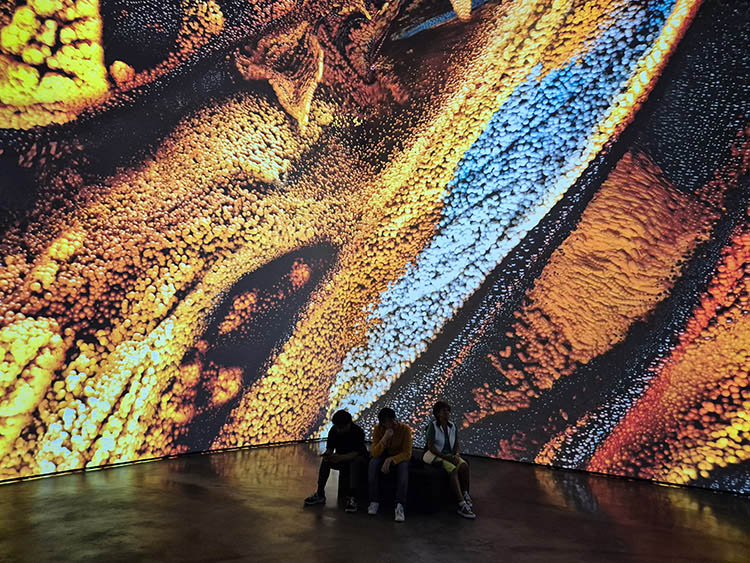
Refik Anadol, Living Architecture: Gehry, 2025.
The first in situ installation in the five-part is entitled Living Architecture: Gehry. At the beginning, if there is one for this looped creation, Refik Anadol shows us what is usually hidden from us: the data set of a vast number of images, in this case relating to the architect's career. This serves to remind us of the essential role of data in artificial intelligence practices, while also commanding respect for the appetite of algorithms that literally “assimilate” it. Then, the images follow one another until the machine, continuing in the same vein, invents architectural forms that never remain static. Then comes the long-awaited moment of what the artist calls “hallucination,” his signature of a grainy material in uninterrupted flow. Kerim Karaoglu's music reinforces the magmatic movements of what springs forth far beyond the surface of the projected image. Prominent artists such as Jeff Koons, whose magnificent tulips adorn the Bilbao Museum, crystallize the commentary. Time will tell what will become of Refik Anadol's aesthetic, which is currently touring the world's institutions. However, its validation by the Guggenheim in Bilbao, following that of the MoMA in New York, gives some indication.
Miami
If there is one place today that embodies immersion, it is Superblue Miami, both in terms of its scale and the quality of its programming, its proximity to the contemporary art world, and its immediate neighborhood with the Rubell Museum, where the experience continues.
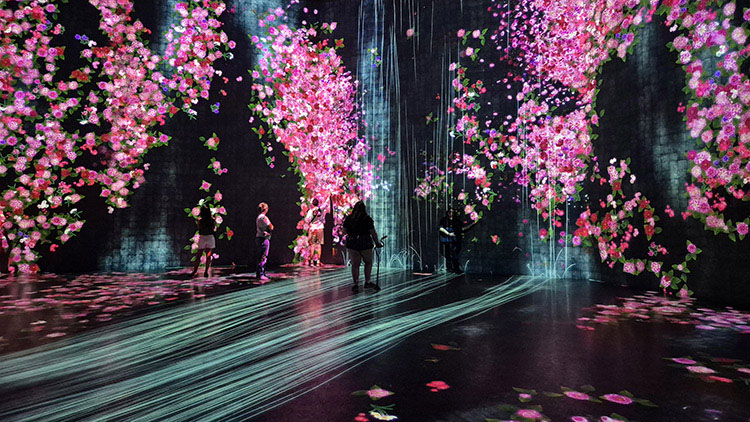
teamLab, Between Life and Non-Life, 2021.
Superblue could not have better embodied immersive practices than by hosting James Turrell's ganzfeld AKHU from its opening in 2021. But it must be acknowledged that the installations brought together under the title Between Life and Non-Life by teamLab have also greatly contributed to its global success. It is indeed difficult to resist the extreme virtuosity of the Japanese collective, which has become a benchmark in the creation of monumental audiovisual museum installations that magnify nature in barely a quarter of a century.
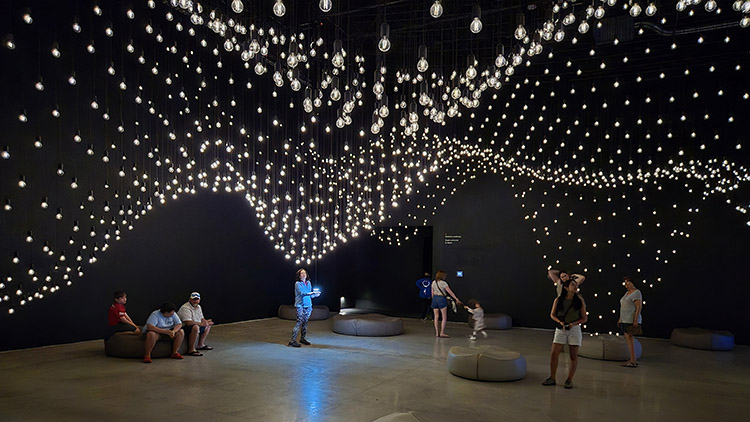
Rafael Lozano-Hemmer, Pulse Topology, 2021.
In the next room, the immersion is sonic and luminous, with the heartbeats of the three thousand light bulbs in Rafael Lozano-Hemmer's Pulse Topology (2021) installation. Sensors allow the audience to assign their heartbeats to one light bulb, then another and another, until they leave this cloud of particles embodying individuals who are only passing through. To the point that entering the dance means accepting to leave it, but without knowing when.
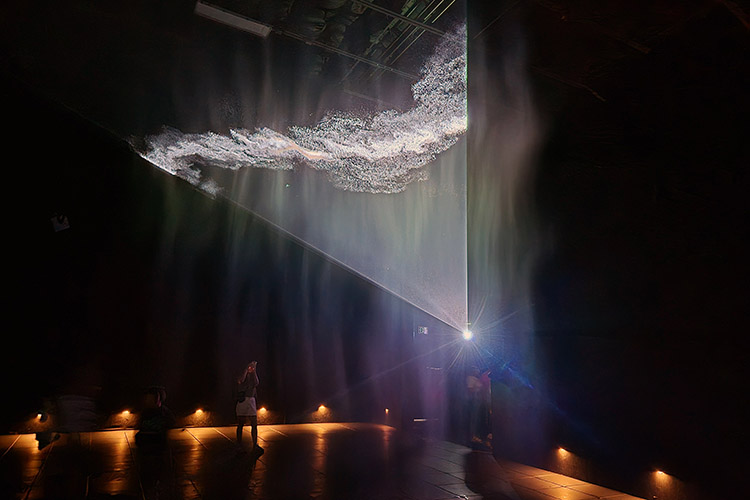
Studio Lemercier, Lightfall, 2024.
The other light installation in the next room is by the Lemercier studio, composed of Joanie Lemercier and Juliette Bibasse, whose electronic music by Murcof reinforces its presence. A work of the immaterial par excellence, Lightfall (2024) consists solely of water vapor delicately revealed by sweeping beams of light. An interaction of the infinitely small that evokes the complementary forces at work in the Milky Way.
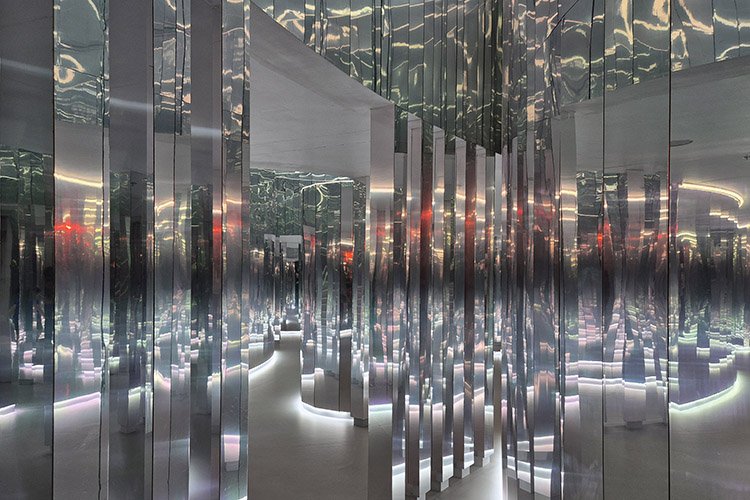
Es Devlin, Forest of Us, 2023.
The ancients represented mirrors before contemporary artists made use of them, as is the case with Es Devlin's Forest of Us (2023). The myriad reflective surfaces singularly increase the complexity of its already labyrinthine architecture. As for its title, evoking this possible forest of ourselves, it could be a metaphor for the multitude of our identities when we interact online.
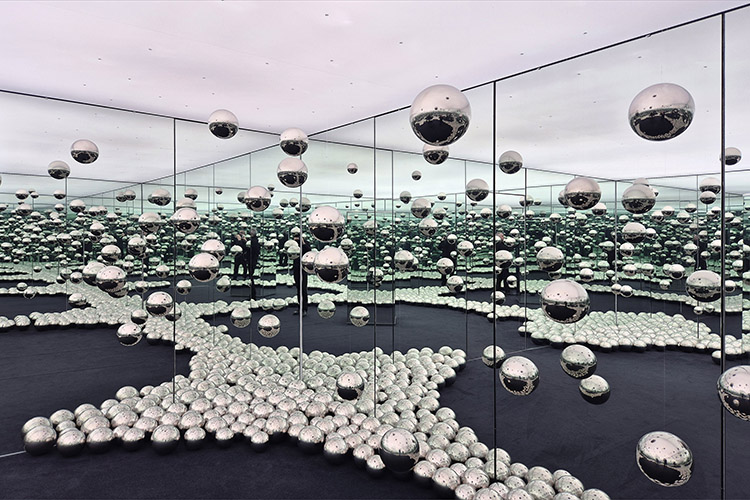
Yayoi Kusama, Infinity Mirrored Room - Let's survive forever, 2017.
The artist, who has been using reflective surfaces to create immersive installations since the 1960s, is Yayoi Kusama, who has more than twenty to her credit. Leaving Superblue, you only must cross the street in this Miami neighborhood to experience her Infinity Mirrored Rooms at the Rubell Museum. Everything that is or enters such environments is multiplied, in line with the proliferation of images on social media. This reflects the exponential enthusiasm of audiences for this immersive trend in art, which is also spreading throughout the creative industry.
New York
At the technical origins of immersion, two solutions allow for large scale image: LED screens, such as those in Times Square, which are also finding their way into museums, including the MoMA, and video projectors used in immersive art venues such as Artechouse in New York.
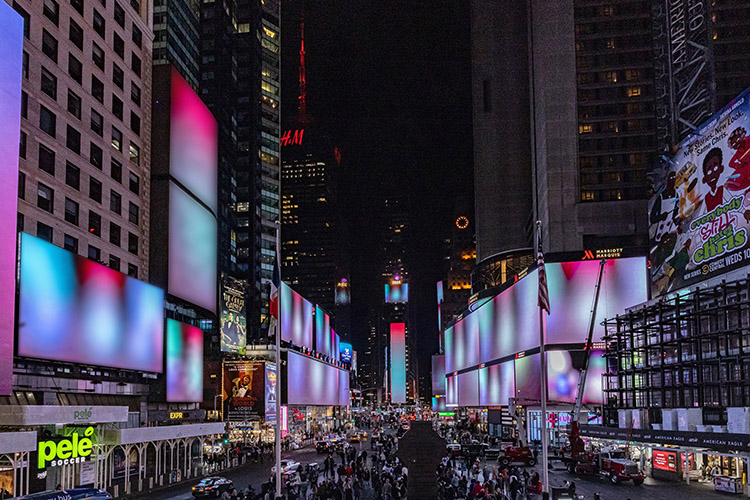
Olafur Eliasson, Lifeworld, New York, 2024, production CIRCA, source Michael Hull.
It wasn't until Midnight Moment that artists took control of the screens in Times Square, as Olafur Eliasson did last year with Lifeworld. To do this, he filmed the square with its advertising animations before blurring the sequences to slow down the tempo and reintegrate them into the screens. The formal unity gives an immersive character to the place, which has lost its consumerist overtones. The abstraction, which takes place every evening between 11:57 p.m. and midnight, offers passers-by three minutes of disconnection.

Yoshi Sodeoka, Infinite Ascent, New York, 2025, source Michael Hull.
At the beginning of this year, it was Yoshi Sodeoka's turn to present Infinite Ascent. He brought the sky back to the screens, where the city is only suggested by silhouettes flown over by birds. An “infinite ascent” by birds, which, by escaping gravity, have always fascinated us. This Midnight Moment can be seen as a call to reconnect with a nature that has never completely deserted Manhattan.

Rafaël Rozendaal, Rio, 2024, Light, MoMA, New York, 2025, programming Reinier Feijen.
For its part, the MoMA couldn't resist the temptation to incorporate a large LED screen to present a series of animations by Rafaël Rozendaal. Initially coded to be presented online at different Web addresses, they take on a whole new dimension here. So much so that the audience can literally enter the image of these short sequences, which are in keeping with the geometric abstraction of the last century, except that here they are performed in real time.
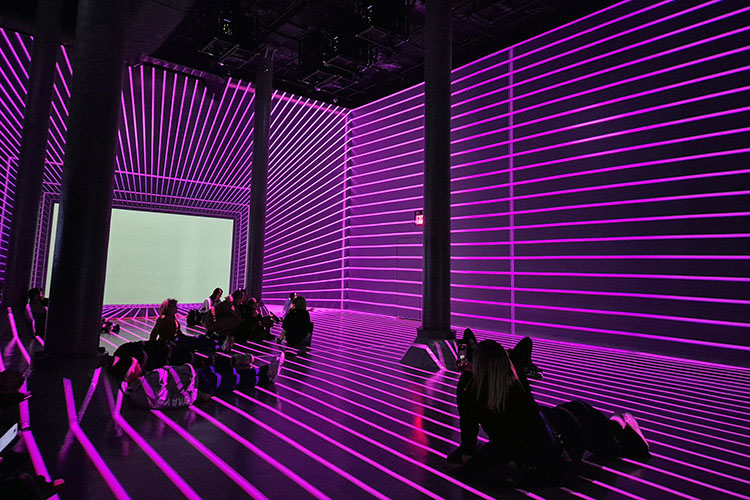
Jérémy Oury, Exo Cortex 3.0, 2025.
Artechouse has set up shop in New York in a former boiler room in Chelsea. The program includes the Submerge project, which brings together some fifteen immersive creations, including those by French artists. There is Exo Cortex by Jérémy Oury, whose projected geometric animations are particularly well suited to the space, to the point of virtually making it disappear, while the synthetic voice that addresses us aims to propel us into an altered state of consciousness.
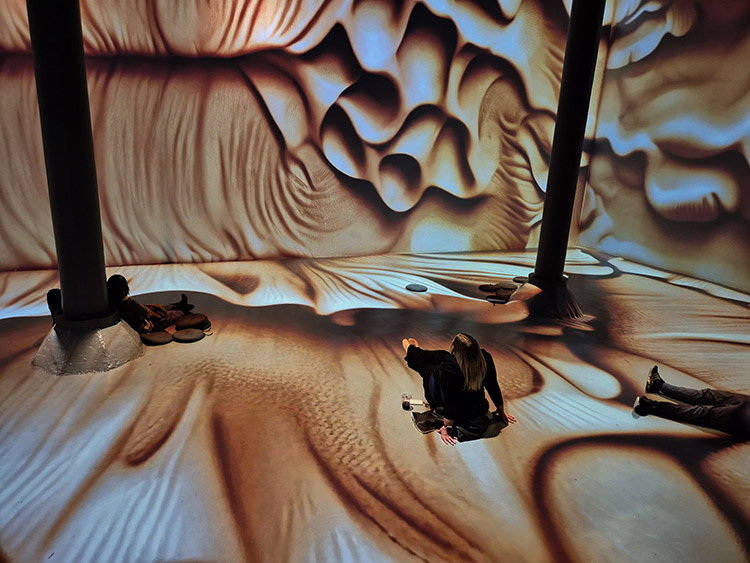
Obvious, Be Water, 2025.
With Be Water by Obvious, we are projected into a decidedly more organic, liquid world. The members of the collective have developed artificial intelligence capable of detecting the movements of video sequences to generate others that embody the title's injunction: “be water.” In other words, adapting to containers, just as immersive content merges with the places it enhances through images.
Articles
- Paris Photo
- Art, technology and AI
- Immersive Art
- Chroniques Biennial
- 7th Elektra Biennial
- 60th Venice Biennial
- Endless Variations
- Multitude & Singularity
- Another perspective
- The Fusion of Possibilities
- Persistence & Exploration
- Image 3.0
- BioMedia
- 59th Venice Biennale
- Decision Making
- Intelligence in art
- Ars Electronica 2021
- Art & NFT
- Metamorphosis
- An atypical year
- Real Feelings
- Signal - Espace(s) Réciproque(s)
- On Combinations at Work
- Human Learning
- Attitudes and forms by women
- Ars Electronica 2019
- 58th Venice Biennale
- Art, Technology and Trends
- Art in Brussels
- Plurality Of Digital Practices
- The Chroniques Biennial
- Ars Electronica 2018
- Montreal BIAN 2018
- Art In The Age Of The Internet
- Art Brussels 2018
- At ZKM in Karlsruhe
- Lyon Biennale 2017
- Ars Electronica 2017
- Digital Media at Fresnoy
- Art Basel 2017
- 57th Venice Biennial
- Art Brussels 2017
- Ars Electronica, bits and atoms
- The BIAN Montreal: Automata
- Japan, art and innovation
- Electronic Superhighway
- Lyon Biennale 2015
- Ars Electronica 2015
- Art Basel 2015
- The WRO Biennale
- The 56th Venice Biennale
- TodaysArt, The Hague, 2014
- Ars Electronica 2014
- Basel - Digital in Art
- The BIAN Montreal: Physical/ity
- Berlin, festivals and galleries
- Unpainted Munich
- Lyon biennial and then
- Ars Electronica, Total Recall
- The 55th Venice Biennale
- The Elektra Festival of Montreal
- Digital practices of contemporary art
- Berlin, arts technologies and events
- Sound Art @ ZKM, MAC & 104
- Ars Electronica 2012
- Panorama, the fourteenth
- International Digital Arts Biennial
- ZKM, Transmediale, Ikeda and Bartholl
- The Gaîté Lyrique - a year already
- TodaysArt, Almost Cinema and STRP
- The Ars Electronica Festival in Linz
- 54th Venice Biennial
- Elektra, Montreal, 2011
- Pixelache, Helsinki, 2011
- Transmediale, Berlin, 2011
- The STRP festival of Eindhoven
- Ars Electronica repairs the world
- Festivals in the Île-de-France
- Trends in Art Today
- Emerging artistic practices
- The Angel of History
- The Lyon Biennial
- Ars Electronica, Human Nature
- The Venice Biennial
- Nemo & Co
- From Karlsruhe to Berlin
- Media Art in London
- Youniverse, the Seville Biennial
- Ars Electronica, a new cultural economy
- Social Networks and Sonic Practices
- Skin, Media and Interfaces
- Sparks, Pixels and Festivals
- Digital Art in Belgium
- Image Territories, The Fresnoy
- Ars Electronica, goodbye privacy
- Digital Art in Montreal
- C3, ZKM & V2
- Les arts médiatiques en Allemagne
- Grégory Chatonsky
- Le festival Arborescence 2006
- Sept ans d'Art Outsiders
- Le festival Ars Electronica 2006
- Le festival Sonar 2006
- La performance audiovisuelle
- Le festival Transmediale 2006
- Antoine Schmitt
- Eduardo Kac
- Captations et traitements temps réel
- Maurice Benayoun
- Japon, au pays des médias émergents
- Stéphane Maguet
- Les arts numériques à New York